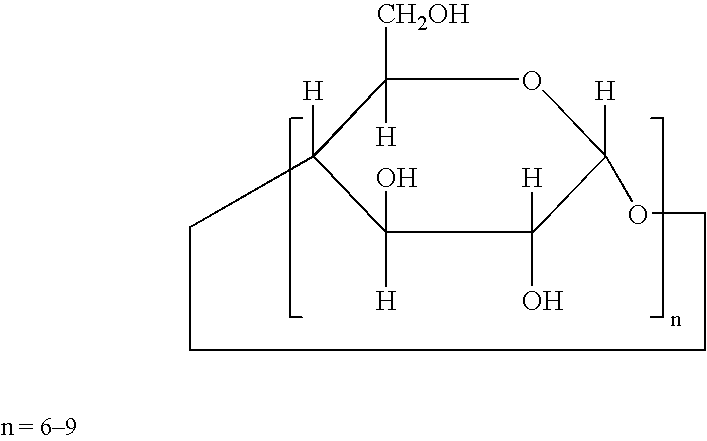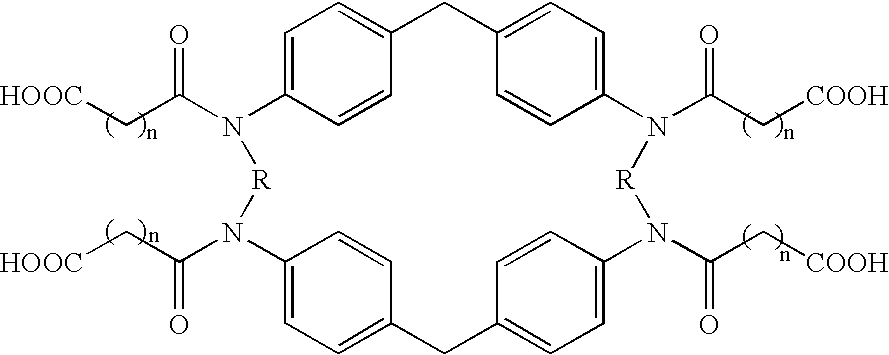Use of chemical chelators as reversal agents for drug-induced neuromuscular block
a neuromuscular block and chemical chelator technology, applied in the direction of anti-noxious agents, drug compositions, biocides, etc., can solve the problems of neuromuscular block, neuromuscular block, muscle flaccidity, etc., and achieve the effect of reversing, not increasing the level of acetylcholine, and less side effects
- Summary
- Abstract
- Description
- Claims
- Application Information
AI Technical Summary
Benefits of technology
Problems solved by technology
Method used
Image
Examples
example 1
Cyclodextrin Derivatives
[0042]Some of the cyclodextrin derivatives that were employed to demonstrate their activity as reversal agents according to the invention were commercially available:
[0043]
CommercialSourceCompound 1: α-cyclodextrin (α-CD)Wacker-ChemieGmbH, Munich,Germany;or ALDRICHCompound 2: carboxymethyl-β-CD (DS = 3.5)Wacker-Chemiesodium saltGmbH, Munich,GermanyCompound 3: 2-hydroxy-3-trimethylammonioWacker-Chemiepropyl-β-CD (DS = 3.5)GmbH, Munich,GermanyCompound 4: per 2,6-dimethyl-β-CD (DS = 12.6)Wacker-ChemieGmbH, Munich,GermanyCompound 5: β-cyclodextrin-phosphate sodium saltCycloLab, Ltd.(DS = 3)Budapest,HungaryCompound 6: β-cyclodextrin-phosphate sodium saltCycloLab, Ltd.(DS = 8)Budapest,HungaryCompound 7: carboxymethyl-β-CD (DS 3–3.5)CycloLab, Ltd.Budapest,HungaryCompound 8: carboxyethyl-β-CD (DS = 3)CycloLab, Ltd.Budapest,HungaryCompound 9: β-cyclodextrin (β-CD)Wacker-ChemieGmbH, Munich,Germany;or ALDRICHCompound 10: 2-hydroxypropyl-β-CDRBI, Natick,MA 01760, USAComp...
example 2
Cyclophane Derivatives
[0044]Nomenclature: the term paracyclophane refers to a family of compounds in which one or more benzene rings are built into a carbocyclic ring system and in which the p-positions of the benzene rings are part of the ring system. The conventional numbering used below for paracyclophane ring systems is that described by Cram and Abell (J. Am. Chem. Soc. 1955, 77, 1179–1186).
A: Tetraaza-paracyclophanes Derivatives:
[0045]
[0046]Scheme A depicts the structures of the N-(carboxy)acylated cyclophane derivatives 19–23, which were prepared by acylation of the parent cyclophanes (see Soga T. et al Tetrahedron Lett. 1980, 4351–4, for synthesis thereof) (1,7,21,27-tetraaza[7.1.7.1]paracyclophane (I), 1,10,24,33-tetraaza[2.2.1.2.2.1]paracyclophane (II) and 3,4,5,6,7,8,26,27,28,29,30,31-dodeca-hydydro-1,10,24,33-tetraaza[2.2.1.2.2.1]paracyclophane (III) with the appropriate activated acid derivative.
A1: Compound 21:
N, N′,N″, N′″-Tetrakis(3-carboxypropionyl)-1, 7, 21, 27-tet...
example 3
Compound 24: cyclo[(1–4)-α-L-rhamnopyranosyl-(1–4)-α-D-mannopyranosyl]-tetraoside
[0069]
[0070]The synthesis of this cyclic octasaccharide is described by Ashton et al. in Chem. Eur. J. 1996, 2, 580–591.
PUM
| Property | Measurement | Unit |
|---|---|---|
| temperature | aaaaa | aaaaa |
| total volume | aaaaa | aaaaa |
| total volume | aaaaa | aaaaa |
Abstract
Description
Claims
Application Information
 Login to View More
Login to View More - R&D
- Intellectual Property
- Life Sciences
- Materials
- Tech Scout
- Unparalleled Data Quality
- Higher Quality Content
- 60% Fewer Hallucinations
Browse by: Latest US Patents, China's latest patents, Technical Efficacy Thesaurus, Application Domain, Technology Topic, Popular Technical Reports.
© 2025 PatSnap. All rights reserved.Legal|Privacy policy|Modern Slavery Act Transparency Statement|Sitemap|About US| Contact US: help@patsnap.com



